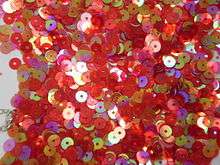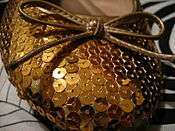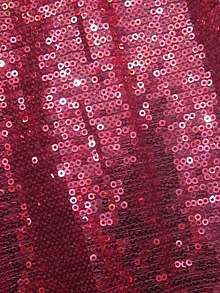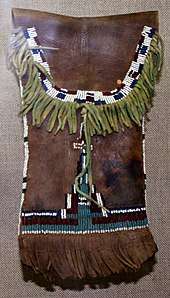Sequin
A sequin /ˈsiːkwɪn/ is a small, shiny, disc-shaped bead used for decorative purposes. In earlier centuries, they were made from shiny metals. Today, sequins are most often made from plastic. They are available in a wide variety of colors and geometrical shapes. Sequins are commonly used on clothing, shoes, bags, jewelry and other accessories.


Sequins are also referred to as paillettes, spangles, or diamanté (also spelled diamante). Although the words sequins, paillettes and spangles can be used interchangeably, diamanté (literally ‘set with diamonds’) is both an adjective and a plural-only noun, which specifically refers to diamond-shaped sequins and can also be used to mean ‘artificial diamonds’, which serve the same purpose as sequins.
In costuming, sequins have a center hole, while spangles have the hole located at the top. Paillettes are typically very large and flat. Sequins may be stitched flat to the fabric, so they do not move, and are less likely to fall off; or they may be stitched at only one point, so they dangle and move easily, catching more light. Some sequins are made with multiple facets, to increase their reflective ability.
History

Evidence exists that gold sequins were being used as decoration on clothing or paraphernalia in the Indus Valley as early as 2500BC, during the Kot Diji phase.[1]
The name "sequin" originates from the Venetian colloquial noun zecchino (Venetian pronunciation: [tseˈkino]), meaning a Venetian Ducat coin, rendered into French as sequin [səkɛ̃]. The Ducat stopped being minted after the Napoleonic invasion of Italy, and the name sequin was falling out of use in its original sense. It was then that the name was taken up in France to designate what it means today. The 19th century sequins were made of shiny metal.
Large spangles, fastened only at the top, have been used on billboards and other signage, particularly prior to the development of lighted and neon signs.
See also
References
- "Kot Diji phase gold sequins". Harappa.com. 2005. Retrieved 1 January 2018.
